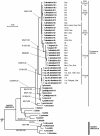Phylogeography and genetic variation of Triatoma dimidiata, the main Chagas disease vector in Central America, and its position within the genus Triatoma
- PMID: 18461141
- PMCID: PMC2330091
- DOI: 10.1371/journal.pntd.0000233
Phylogeography and genetic variation of Triatoma dimidiata, the main Chagas disease vector in Central America, and its position within the genus Triatoma
Abstract
Background: Among Chagas disease triatomine vectors, the largest genus, Triatoma, includes species of high public health interest. Triatoma dimidiata, the main vector throughout Central America and up to Ecuador, presents extensive phenotypic, genotypic, and behavioral diversity in sylvatic, peridomestic and domestic habitats, and non-domiciliated populations acting as reinfestation sources. DNA sequence analyses, phylogenetic reconstruction methods, and genetic variation approaches are combined to investigate the haplotype profiling, genetic polymorphism, phylogeography, and evolutionary trends of T. dimidiata and its closest relatives within Triatoma. This is the largest interpopulational analysis performed on a triatomine species so far.
Methodology and findings: Triatomines from Mexico, Guatemala, Honduras, Nicaragua, Panama, Cuba, Colombia, Ecuador, and Brazil were used. Triatoma dimidiata populations follow different evolutionary divergences in which geographical isolation appears to have had an important influence. A southern Mexican-northern Guatemalan ancestral form gave rise to two main clades. One clade remained confined to the Yucatan peninsula and northern parts of Chiapas State, Guatemala, and Honduras, with extant descendants deserving specific status. Within the second clade, extant subspecies diversity was shaped by adaptive radiation derived from Guatemalan ancestral populations. Central American populations correspond to subspecies T. d. dimidiata. A southern spread into Panama and Colombia gave the T. d. capitata forms, and a northwestern spread rising from Guatemala into Mexico gave the T. d. maculipennis forms. Triatoma hegneri appears as a subspecific insular form.
Conclusions: The comparison with very numerous Triatoma species allows us to reach highly supported conclusions not only about T. dimidiata, but also on different, important Triatoma species groupings and their evolution. The very large intraspecific genetic variability found in T. dimidiata sensu lato has never been detected in a triatomine species before. The distinction between the five different taxa furnishes a new frame for future analyses of the different vector transmission capacities and epidemiological characteristics of Chagas disease. Results indicate that T. dimidiata will offer problems for control, although dwelling insecticide spraying might be successful against introduced populations in Ecuador.
Conflict of interest statement
The authors have declared that no competing interests exist.
Figures





References
-
- Schmunis GA. Medical significance of American trypanosomiasis. In: Maudlin I, Holmes PH, Miles MA, editors. The Trypanosomiases. Wallingford, UK: CAB International; 2004. pp. 355–368.
-
- World Bank. World Development Report 1993. Investing in Health. New York: Oxford University Press; 1993. p. 329.
-
- Dujardin JP, Schofield JC, Panzera F. Les Vecteurs de la Maladie de Chagas. Recherches taxonomiques, biologiques et génétiques. Brussels: Académie Royale des Sciences d'Outre Mer, Classe des Sciences Naturelles et Médicales; 2000. p. 162.
-
- Bargues MD, Marcilla A, Ramsey J, Dujardin JP, Schofield CJ, et al. Nuclear rDNA-based molecular clock of the evolution of Triatominae (Hemiptera: Reduviidae), vectors of Chagas disease. Mem Ins Oswaldo Cruz. 2000;95:567–573. - PubMed
-
- Bargues MD, Marcilla A, Dujardin JP, Mas-Coma S. Triatominae vectors of Chagas disease: a molecular perspective based on nuclear ribosomal DNA markers. Trans Roy Soc Trop Med Hyg. 2002;96(S1):159–164. - PubMed
Publication types
MeSH terms
Substances
Associated data
- Actions
- Actions
- Actions
- Actions
- Actions
- Actions
- Actions
- Actions
- Actions
- Actions
- Actions
- Actions
- Actions
- Actions
- Actions
- Actions
- Actions
- Actions
- Actions
- Actions
- Actions
- Actions
- Actions
- Actions
- Actions
- Actions
- Actions
- Actions
- Actions
- Actions
- Actions
- Actions
- Actions
- Actions
- Actions
- Actions
- Actions
- Actions
- Actions
- Actions
- Actions
- Actions
- Actions
- Actions
LinkOut - more resources
Full Text Sources
Medical

